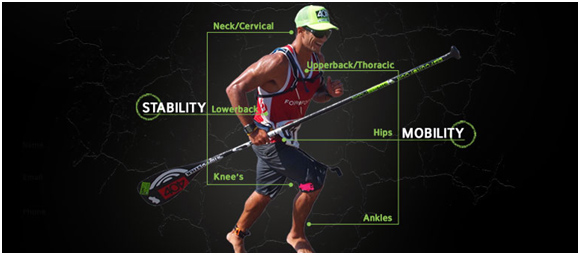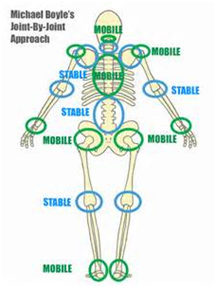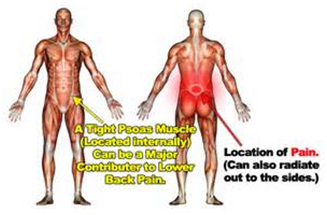By Dr. Amanda Scione DC., B.Sc Kin.

Have you ever been performing an activity and then wake up the next day in pain…leaving yourself wondering what you did to yourself to cause this? Or how about when the pain is not going away despite treatment to the area?Have you ever wondered why therapists treat adjacent regions of your body that are not necessarily painful?
Answers to these questions will be illustrated by explaining the principles of the joint by joint approach, how pain in one area may be caused by dysfunction in another, and how these issues can be resolved.
1) The Joint by Joint Approach- understanding mobility and stability
Whether you engage in moderate or intense physical activity it is important for you to understand the following concepts. As a patient, it is important to understand the basics of how your body functions. This will make you more in tune with your body, and will allow you to feel when something is ‘not right’. The Joint by Joint Approach was coined by Michael Boyle and Gray Cook. Their analysis of the body is very straightforward. Our bodies are merely seen as a stack of joints. Each joint or series of joints has a specific function, and therefore, has particular training needs. Notice below that our joints alternate between mobility and stability.

2) Pain in one area may be caused by dysfunction in another area of the body
If the specific functions of each joint are not met, our bodies are prone to predictable levels of dysfunction. Problems at one joint usually show up as pain in the joint above or below. Let’s use the common condition of lower back pain to illustrate this. I am sure you know by now that if you have lower back pain you need to work on your core exercises. BUT, what you may not know is that this lower back pain probably evolved due to a loss of hip mobility. As we previously discussed, when we have loss of function in one joint (lower spine), we also get loss of function of the joint below (the hips). This means that if the lumbar spine can not move, the hips will instead. The problem is that the hips are designed for mobility, and the lumbar spine for stability. When the intended mobile joint becomes immobile, the stable joint is forced to move as compensation, becoming less stable and subsequently painful.

Let’s analyze this pattern further. As shown in the diagram, decreased strength or activation of the psoas muscle will cause patterns of lumbar flexion as a substitute for hip flexion. Decreased strength or activation of the glut muscles will cause a compensatory extension pattern of the lumbar spine to replace the motion of hip extension. This cycle is a vicious one. As the spine moves to compensate for the lack of strength and mobility of the hip, the hip loses more mobility.
Quick Summary of patterns:
Loss of ankle mobility » knee pain
Loss of hip mobility » low back pain
Loss thoracic mobility » neck and shoulder pain, or low back pain

Remember that the chain starts from the bottom. An immobile ankle causes the stress of landing to be transferred to the joint above, the knee- and the cycle continues up.
3) How these can be resolved so the patient gains mobility and decreases pain
Utilizing the FIT principle, the chiropractors at Athlete’s Care are equipped in identifying these patterns of altered joint mechanics as well as correcting them through many different treatment strategies. We find and treat the cause of the pain rather than focus on the source of the pain. Elite athletes utilize this approach for performance optimization. They are constantly assessed for altered joint mechanics BEFORE compensation and pain sets in. Visit your nearest chiropractor at Athlete’s Care to get your body assessed now!
Dr. Amanda Scione is a chiropractor currently seeing patients at the Athlete’s Care Oakville location. Wait for upcoming news on the Hamilton location.


















